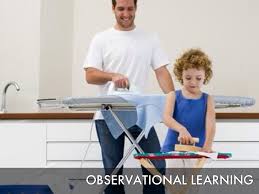Albert Bandura – Social Learning Theory
Observational learning or the social learning theory is presented by Albert Banura (1977). Bandura agreed with the behavioral theories of learning, specifically classical and operant conditions, however, he argued that behavior is learned through the interaction with the environment, observational learning, and that mediating processes will occur between stimuli and response.
•Grew out of Cognitive theories
•Learning takes place through observation and sensorial experiences
•Imitation is the sincerest form of flattery
•SLT is the basis of the movement against violence in media & video games
Observational Learning: Learning new behavior by watching a model behave
- Learning/performance distinction: learning can take place without actual performance of the learned behavior
Observing and Imitating Another’s Behavior – Social/Observational Learning
•Occurs when an observer’s behavior changes after viewing the behavior of a model
Learning From Models
•Retain in memory
•Accurately reproduce the observed activity
•Possess sufficient motivation to apply new learning
Elements of Observational Learning:
1.Attention
–To learn anything through observation, the learner must first pay attention to the model.
2.Memory
–The le arner must also be able to retain the memory of what was done, such as remembering the steps in preparing a dish that were first seen on a cooking show.
arner must also be able to retain the memory of what was done, such as remembering the steps in preparing a dish that were first seen on a cooking show.
3.Imitation
–The learner must be capable of reproducing, or imitating, the actions of the model.
4.Motivation
–The learner must have the desire to perform the action.
- Children viewed one of two conditions:
–Aggressive model
–Non-aggressive model
- Results
–Viewers of aggression played more aggressively 
–Model’s behavior was imitated even in absence of reward
Four interrelated processes establish and strengthen identification with the model:
•Children want to be like the model
•Children believe they are like the model
•Children experience emotions like those the model is feeling.
•Children act like the model.
Through identification, children come to believe they have the same characteristics as the model
•When they identify with a nurturing and competent model, children feel pleased and proud.
•When they identify with an inadequate model, children feel unhappy and insecure.
Bandura and Maslow
•Collaborative learning and group work
•Modeling responses and expectations
•Opportunities to observe experts in action
•All students are intrinsically motivated to self actualize or learn
•Learning is dependent upon meeting a hierarchy of needs (physiological, psychological and intellectual)
•Learning should be reinforced.
Bandura’s research indicates that the following factors influence the strength of learning from models:
•How much power the model seems to have
•How capable the model seems to be
•How nurturing (caring) the model seems to be
•How similar the learner perceives self and model
•How many models the learner observes
References:
Bernstein, D.A. & Nash, P.W. (2008). Essentials of psychology (4th ed.) Boston: Houghton Mifflin Company.
Feldman, R. (2013). Essentials of understanding psychology (11th ed.). New York, NY: McGraw-Hill.
Friedman, H.S. & Schustack, M.W. (2012), Personality: classic theories and modern research (5th ed). Boston: Pearson Allyn & Bacon.
McGraw-Hill.McGraw Hill Higher Education (2013), The McGraw Hill Companies, Inc.
Ryckman, R. M. (2013). Theories of personality (10th ed.). Mason, OH: Cengage Learning.
